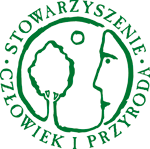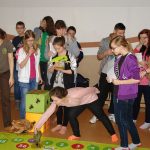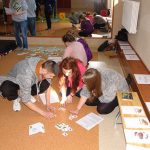The second lecture, with the same title, took place on March 31st, in Primary School in Stary Folwark.
This 3-hour talk was attended by 22 4th grade students and 2 teachers.
As the previous one, this lecture was based on a multimedia presentation enriched with classes based on the large format board game 'Let's play green'.
During the lecture the students had the opportunity to get to know the biology of amphibians found in their nearest surroundings. The children learned about selected species of amphibians, both caudate and anuran, occurring in the area of north-eastern Poland.
Thanks to amphibians models, the observation of individual species characteristics was much easier. They also helped to draw attention to the fundamental differences between species. It was mainly their size.
Games and activities that accompanied the classes made them much more attractive. Quizzes were also organized in which students had the opportunity to test their knowledge. The sound quiz was quite difficult, but the kids did not have problems with recognizing those species they directly observed in the nearest surroundings.
The lecture was conducted before Easter, therefore, the students prepared a unique Easter decoration, whose main feature was the image of European tree frog in tegrated in to an Easter egg.
These activities have given foundations to further training of this group of students engaged with monitoring amphibians.
In case of both lectures, the participants received a set of educational materials, and the winners of competitions - small amphibian related gifts.
On March 26th, in Gymnasium No. 2 in Suwałki, a lecture called 'Amphibians protection in Natura 2000 area in north-eastern Poland' took place.
This 4-hour talk was attended by 30 students from 2nd grade. Most of this school's students live outside of Suwałki, in villages located within the borders of Wigry National Park and its buffer zone. The school itself implements a number of initiatives in the field of ecology.
The lecture was based on a multimedia presentation, enriched with classes based on the large format board game 'Let's play green'.
The lecture was supposed to prepare students to conduct science observations - observations of amphibians in different environments and in different stages of their development. The children got to know the details of amphibians composition, their behavior, they learned to recognize and assign the sounds of various species of amphibians to their images.
The students also learned about amphibians protection. The children especially showed in terest in the action of protecting amphibians along communication routes during their spring migration.
Watching amphibian models (scale 1:1) also proved to be an excellent pictorial material. The students were also able to share their own observations made on field trips organized by the school, as well as those acquired during in dividual trips.
The board game 'Let's play green' was a very in teresting element of the summary and perpetuating the children's knowledge. 6 teams of 6, using 6 large pieces, attempted to lead their amphibians through natural environment full of surprises, in cluding those unpleasant ones, and many dangers. The winner was the team that finished first. All the students were doing very well, and also had the opportunity to test their knowledge in quizzes and a tournament.
Between Mar 10-12, the LIFE12 NAT/PL/000063 project implementation was controlled under contract with the National Fund for Environmental Protection and Water Management. The scope of the audit in cluded:
- control of compliance of the in itiatives with the terms of the grant agreement (including material and financial schedule),
- checking the basic formal and legal documents related to implementation of the project,
- control of the eligibility of expenditure for the correctness of documents attached do settlement and submitted to the National Fund for Environmental Protection and Water Management preparation and their conformity with the original documentation and the implemented scope,
- verification of the scope of work contracts conformity with the scope of the project and determination the mode in which contracts were signed,
- verification of compliance of the in formation and promotion activities with the terms of the agreement
- controlling the way of archiving (storage ) documents related to the project.









